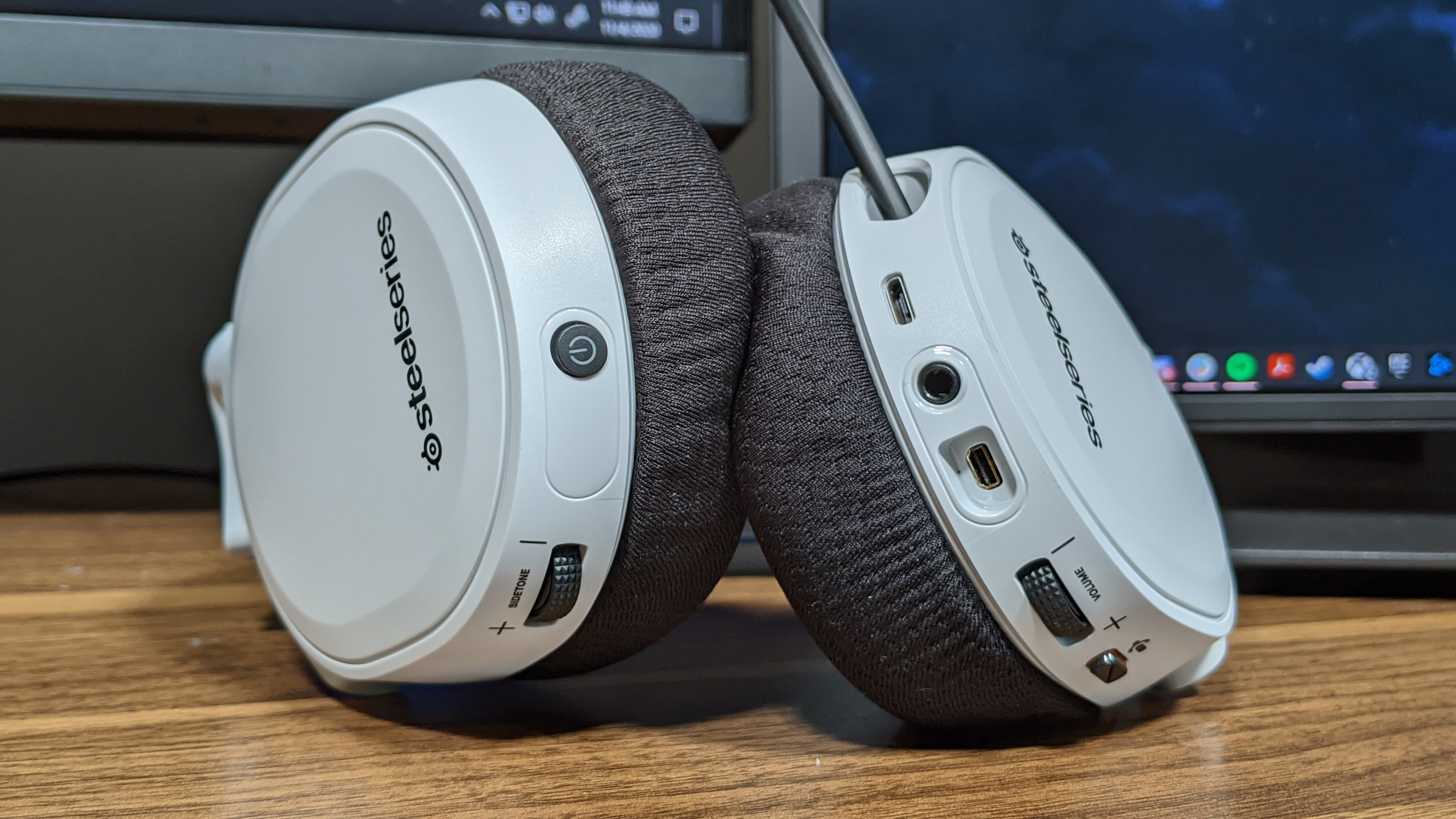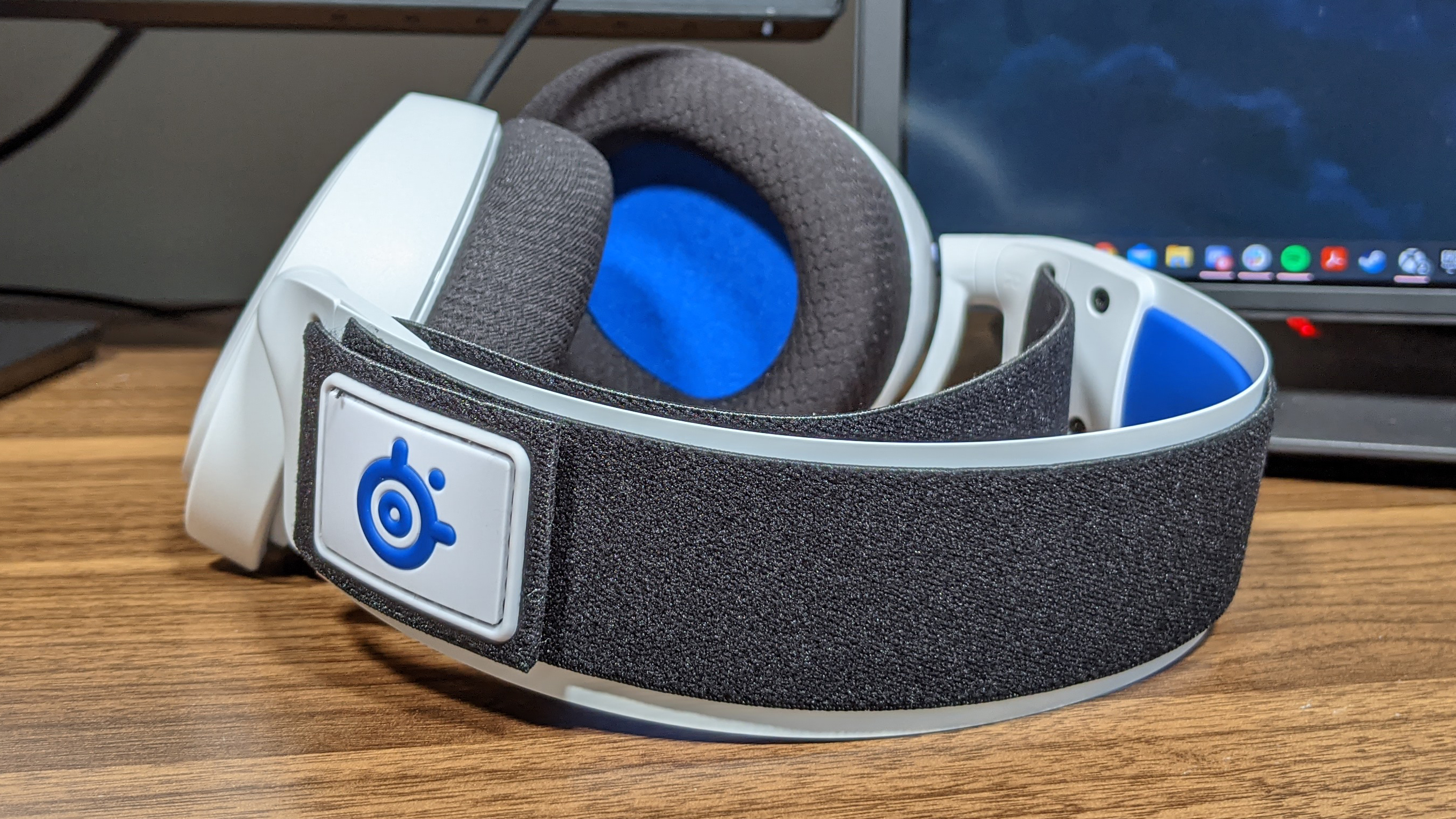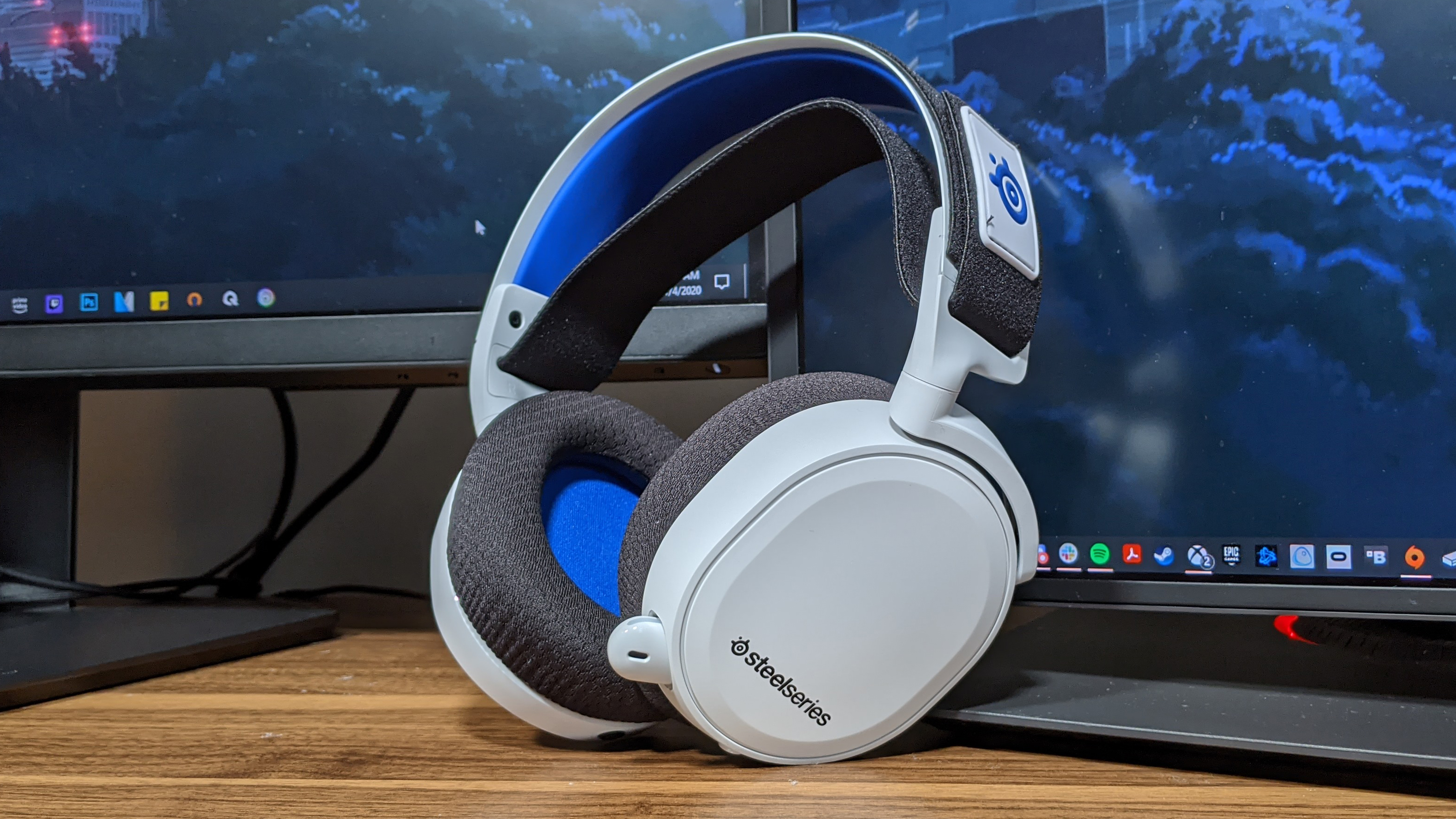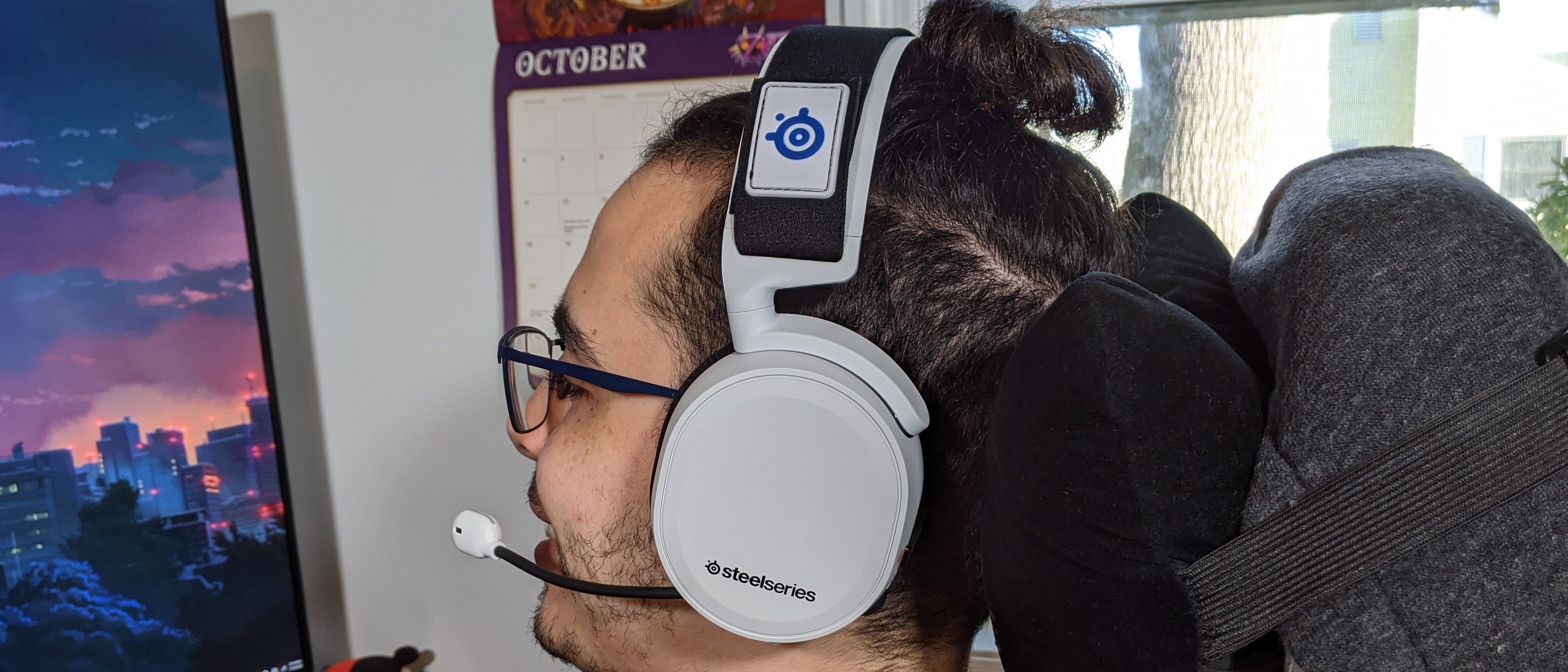Laptop Mag Verdict
The SteelSeries Arctis 7P is a PS5 wireless gaming headset packed with great audio performance, sublime comfort and long battery life.
Pros
- +
Solid gaming audio
- +
Premium aluminum design
- +
Comfortable ear cups
- +
Retractable, noise cancelling microphone
- +
Long battery life
- +
Works with almost every platform
Cons
- -
Music could sound better
- -
No EQ settings
- -
No USB Type-C charging
Why you can trust Laptop Mag
If you’re scrambling for a gaming headset that takes advantage of the PS5’s new 3D Tempest audio, look no further than the SteelSeries Arctis 7P.
For $149, you’ll get premium gaming audio, a sleek aluminum design and plushy ear cups packed into a headset that works wirelessly with almost every platform. Sure, the music quality could be better, and it would’ve been nice to have some EQ settings and USB Type-C charging, but between the headset’s long battery life and retractable, noise cancelling microphone, it’s easy to overlook these flaws.
The SteelSeries Arctis 7P is not only the most well equipped PS5 headset you can get on launch day, but it’s one of the best gaming headsets you can buy overall.
SteelSeries Arctis 7P design
The SteelSeries Arctis 7P unmistakably looks like a PS5 headset, but that’s not a bad thing. Like its siblings, it features a durable steel band wrapped in a woven ski goggle fabric suspension headband. The band is thick and durable, which already distinguishes itself among the large crop of plastic gaming headsets. There’s blue padding slightly protruding from the base, which gives the Arctis 7P a nice offset to the white. It would’ve been nice to see blue stitching in the headband similar to the green accents on the Xbox version.
The ear cups are matte white, and below the center of each cup is a black SteelSeries logo. The insides of the cups are blue, while the cushions feature a neat hexagonal pattern. Like the rest of SteelSeries’ premium headset, there’s a slit above the cups where the band slides in and lets you adjust the size. The headset doesn’t get any bigger or smaller, rather, the band attunes to your head based on how tight the velcro strap is.

There are a healthy number of controls and ports on the Arctis 7P. From top to bottom on the left cup, there’s the mute button, a volume rocker, the Share Port, a 3.5 audio jack, a microUSB port for charging and the retractable ClearCast microphone. The right cup features the power button and a sidetone rocker. The aforementioned Share Port lets you plug another user into your headset with an included proprietary cable so you can share audio. Unfortunately, there’s no USB Type-C charging, which we’ve seen on cheaper headsets, like the HyperX Cloud Stinger Core Wireless.
In the box, you’ll find the 2.4-GHz USB Type-C receiver, a female USB Type-C to male USB Type-A adapter, a USB Type-A to micro-USB cable for charging and the Share Port cable, which is a proprietary audio jack that feeds into a male 3.5mm audio port. SteelSeries does not include a traditional 3.5mm audio cable in the box.
Sign up to receive The Snapshot, a free special dispatch from Laptop Mag, in your inbox.
SteelSeries Arctis 7P comfort
SteelSeries stays true to the cliche “if it ain't broke, don't fix it” by recycling its Airweave fabric ear cushions and bringing it to the Arctis 7P. These are still so damn comfortable. They sit snugly over my ears and put just enough pressure to block out noise without cutting off blood circulation.

The ski goggle headband felt a little different this time around due to my huge head of hair, so I had to loosen it up a bit, but it felt practically nonexistent against my scalp. Thanks to the velcro strap, the headset is easy to adjust, but it can take a bit of time pulling it apart and sticking it back together again. It makes me worry about the longevity of the velcro against the cloth material.
At 12.9 ounces, the Arctis 7P is lighter than some of its siblings, including the SteelSeries Arctis 9X, which weighs 13.1 ounces. It’s less noticeable on my head than the Arctis 9X, but if I move around from side to side too quickly, I can feel the headset shift.
SteelSeries Arctis 7P gaming performance
The SteelSeries Arctis 7P uses 40-millimeter neodymium drivers that packed a punch while I was gaming. The cans were great at not only highlighting voices over other tracks, but balanced music and sound effects so everything meshed well. It even has decent bass, though the low-end isn’t strong enough to add much depth.

In Crash Bandicoot 4: It’s About Time, I was hit with nostalgic tunes from a vibrant xylophone as I dived into the first level of N. Sanity Island. Breaking boxes sounded more crisp and satisfying than usual, which is surprising because I actually prefer the sound effect from the N. Sanity Trilogy. When I went to The Hazardous Wastes, Doctor N. Gin taunted me as I jumped and slid my way through the desert, and while his taunts were in vain, his voice was pleasantly front and center over the rest of the sound effects and music.
I tore through a Mongol camp in Ghost of Tsushima, and soon as my katana sliced through the chest of my enemy, a sharp, meaty sound reverberated through my ears. It sounded so intense, I thought I had killed him in one blow, but when I quickly realized I didn’t, I parried his sword, which made a rich, clanking sound. What made the fight even more intense were the thick drums that backed up my every move. The bass wasn’t perfect, but the intensity definitely came through.
In Watch Dogs: Legion, the SteelSeries Arctis 7P was excellent at highlighting the low suspenseful beat during cutscenes, which immersed me in this game way more than usual. The voice dialogue was crisp and loud enough to take priority over all of the hacking sound effects. When I started driving, the low humming of the engine was surprisingly pleasant until I slammed into a cop car, creating a heavy crashing sound.
SteelSeries Arctis 7P music performance
Even when blasting music, the SteelSeries Arctis 7P sounded good. I could distinguish most instruments throughout a song, as it highlighted the mids and highs very well, but percussion wasn't treated to well-rounded bass. And more often than not, vocals took a backseat to other instruments, which didn’t sit well with me.

In Thousand Foot Krutch’s “Be Somebody,” the opening electric guitar riffs completely overshadowed the vocals. It’s almost like hearing a child scream while you’re trying to watch a movie. What vocals I could hear sounded clear and the guitar had a lot of depth, sounding practically perfect. Unfortunately, the headset doesn’t have an EQ to balance the audio to favor vocals. Apart from that, the percussion produced thick albeit quiet beats.
I was actually surprised by the bass in mxmtoon’s “ok on your own,” as the soft, yet crisp vocals were matched with heavy percussion that provided an impact reminiscent of a baby subwoofer jolting bass into my chest. The song proved that the Arctis 7P can produce decent bass, but it’s not full enough to be on a par with something like the Sony WH-1000XM3. Surprisingly, the ukulele didn’t overshadow the vocals, but they were on even ground for a majority of the opening.
I had an interesting experience listening to Nano’s “Kemurikusa,” where the percussion was actually front and center, complimenting the vocals, which called shotgun. The guitar and electronic beats were a lot quieter during some parts of the song. It got occasionally muddy, but during the chorus, each instrument had room to flourish without sounding congested.
SteelSeries Arctis 7P microphone
The Arctis 7P’s retractable ClearCast bidirectional microphone sounded pretty good, and the noise-cancelling worked well, but the sidetone picked up everything in my room.

My voice was clear and crisp and the microphone’s noise-cancelling feature worked quite well. It blocked out my fingers typing this very sentence on my mechanical keyboard, my neighbor cutting down their tree, and my fiancée watching TV in the living room. During my testing, I noticed that the sidetone is a very inaccurate representation of how I sounded and how my audio was coming through. For example, all of the aforementioned sounds were picked up by the sidetone. Mine was set to 100%; you can lower it, of course, but you’ll have to tinker for a while to get something equivalent to what you really sound like.
SteelSeries Arctis 7P features
While the biggest selling feature of the SteelSeries Arctis 7P is its compatibility with the PS5, the headset can also be used with basically any device. It can connect wirelessly to the Nintendo Switch, PC, Android devices and the Google Stadia controller. And thanks to its 3.5mm jack, it can even connect to the Xbox Series X.

As I mentioned earlier, the headset doesn’t feature any EQ settings, so there’s no software that can help you along if you’re having some audio balancing issues.
Meanwhile, SteelSeries advertises 24 hours of battery life with the SteelSeries Arctis 7P. That matches up with my own testing of the product, as it took a couple days before I needed to recharge after jumping between 8-hour workdays and 4-hour gaming sessions. It’s frustrating, however, not knowing how much battery life is left.
Bottom line
If you’re in need of a great gaming headset when the PS5 launches, the SteelSeries Arctis 7P will do all of the work for you. It’ll bless you with great performance, snuggle your ears with plush comfort, stand by you for several days without dying, and even successfully connect to all your devices without causing a fuss. Of course, the music performance isn’t ideal, and there are a couple of missing features I wish it had.
If you’re looking for something more premium that’ll also work on the PS5, check out the JBL Quantum One, which is a premium gaming headset with 7.1 virtual surround sound and active-noise cancelling. However, it costs $300.
For $149, the SteelSeries Arctis 7P perfectly blends performance and build quality for a relatively affordable price.

Rami Tabari is the Reviews Editor for Laptop Mag. He reviews every shape and form of a laptop as well as all sorts of cool tech. You can find him sitting at his desk surrounded by a hoarder's dream of laptops, and when he navigates his way out to civilization, you can catch him watching really bad anime or playing some kind of painfully difficult game. He’s the best at every game and he just doesn’t lose. That’s why you’ll occasionally catch his byline attached to the latest Souls-like challenge.

